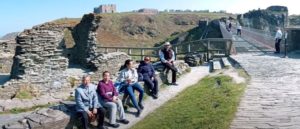Mass tourism forces mobbed museums to overhaul welcome

PARIS : Mass tourism spurred by cheap flights and richer emerging economies is forcing the world’s top museums to rethink their welcome, notably by boosting access, embracing apps and improving ancillary services such as eateries and gift shops.
The overhaul is dictated by the sheer numbers of visitors crowding galleries to catch a glimpse of the Mona Lisa, a Van Gogh canvas or a Michelangelo statue.
Nearly 10 million people a year pass through the Louvre, seven million visit the British Museum, and six million go to the Met in New York.
“The Louvre was conceived for five million people. For the past three years straight we’ve had more than nine million,” noted the president of the vast Paris museum, Jean-Luc Martinez.
He has launched a “Pyramid Project” for the Louvre that aims by mid-2016 to improve entry through redesigned ticket offices, lines and cloakrooms.
“If the visitors aren’t taken care of, how can you expect their experience seeing the works of art to pass off well?” Martinez asked.
Coping with the crowds is also a concern for Glenn Lowry, director of New York’s Museum of Modern Art, or MoMA.
A decade after an extension that saw MoMA double its capacity to three million visitors a year, the museum wants to grow again by tearing down an adjacent building.
The famous Palace of Versailles outside Paris is expanding, too. It will soon open a 2,700-square-meter space to take in some of the 10 million people who come each year to tour the chateau and its park.
Some museums, aware of their status as prime tourism destinations, are also opting to increase the quality of their restaurants, such as the Guggenheim in Spain, and to develop designer gift shops, mimicking MoMA’s envied retail outlet.
Another option to improve access is extending the opening hours. Since 2013, visitors can go to MoMA and the Met in New York every day of the week. The French government is asking the Louvre, Versailles and the Musee d’Orsay to follow suit.
But for the head of the Louvre, “the problem isn’t about doing more, but doing better”.
The Musee d’Orsay’s president, Guy Cogeval, agreed that finding a way to manage 3.5 million visitors annually was a priority. “Traffic management is one of my big concerns. We are trying to better spread the visitors around” the various sections of the Paris museum.
With globalisation, there are not only more and more people trying to squeeze through the doors of the world’s museums, but they hail from many more cultures and countries than in the past.
Museums are finding that they no longer cater to a public well-versed in the history and artistic movements on show, but to visitors needing more context and information to process what they are seeing.
“We are still far from learning the lessons from this diversification,” said Alain Seban, who has run the Pompidou Centre in Paris for the past eight years.
Foreigners make up 70% of the Louvre’s visitors and 80 percent of Versaille’s, with Chinese in particular a growing contingent.
“This imposes another way to receive them and to try to understand what they have come to see,” said the president of the Palace of Versailles, Catherine Pegard.
Susan Foister, spokeswoman for the National Gallery in London, concurred.
“We think a lot more these days about who makes up our audience and what they need from their encounters at the National Gallery,” she said.
Often in groups or families, tourists from afar tend to take in a museum by making bee-lines for its most famous artworks: the Mona Lisa painting and the Venus de Milo statue at the Louvre, for instance.
Polling shows that many visit just one landmark museum per year, and that their average age has dropped significantly. At the Musee d’Orsay 30% of the visitors are under 26, and at the Louvre half are younger than 30.
That makes for some unusual success. The Musee d’Orsay, for instance, was surprised to see “a lot of young people” turn up to an exhibition of works by a little-known French painter named Jean-Leon Gerome, whose paintings recalled the heroic dioramas used in video games.
So how can the museums adapt to the changing face of their visitors?
“You have to start from the idea that these people know nothing,” said Martinez from the Louvre. References that might seem obvious need explaining, with multiple translations.
French museums are applying lessons learnt from starting up outposts in different parts of the country, or abroad.
Several museums are ramping up their digital offerings to support their collections, giving visitors the opportunity to load information into their smartphones or tablets before walking the halls.
At the Pompidou Centre, where two out of three visitors brandish a smartphone, an application will soon be launched that offers the user a tailored walk-through, based on interests revealed through a quiz.
Seban said the future would probably see visits increasingly personalised, with museums borrowing tactics and technology from the big retailers.
The Internet is also sustaining a virtual model of the museums that is just as popular as the real thing. The Met’s website last year received more than 26 million visits, while the National Gallery had six million.
“It’s paradoxical to present the amount of visitors as a problem,” said Martinez. “A museum’s mission, after all, is to allow the widest public possible the chance to see its collections.” – AFP March 2015














